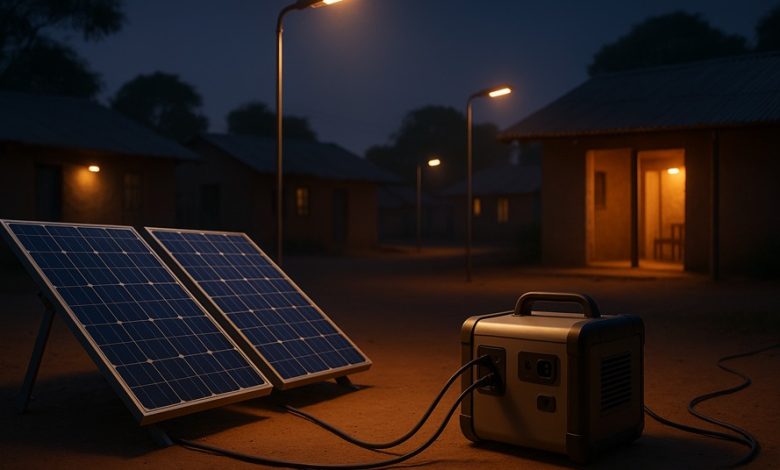
Delivering dependable light to off-grid villages is the first step toward evening literacy classes, safer streets and longer hours for shops. All around the world, nonprofits now rely on solar generators to be able to deliver that light, fast and at a low operating cost. With efficient LEDs and basic training agendas, a portable solar power generator can transform a settlement from the dark into light, and help turn it into an attractively lit community center to boot, all without a need for fuel deliveries or noisy engines.
DIY Solar Generators: Why Nonprofits Are Switching From Diesel to Solar
Old-fashioned diesel engines sound cheap to buy, but very expensive to keep alive. Fuel has to be carted over hard roads, prices vary widely and breakdowns are frequent. Solar by contrast produces electricity, day in and day out on site with zero intervention necessary. Batteries store energy for the evening, inverters deliver clean AC power to run your lights, and smart charge controllers help protect your hardware.
Solar also improves trust. Who can object to a little peace and quiet, no fumes and predictable “free” sunshine instead of fees linked to fuel trucks? For NGOs, every dollar saved on diesel can be spent instead on school materials, training or more lights. Over a several year basis, solar is usually the least expensive option for community lighting even when battery renewal costs are budgeted.
See a Portable Solar Power Generator in Action
When normal people, and even solar power pros say portable solar power generators, they are typically talking about a heavy-duty suitcase or wheeled power station that unfolds or can be rolled to where you need backup power times several copies of flexible or rigid PV panels. The enclosure contains four basics, a lithium battery (commonly LiFePO₄ for safety and long cycle life), a solar charge controller, an inverter which provides AC outlets and DC outputs directly to LED lighting. Some models offer app-based monitoring, swappable fuses and weather-sealed ports. In the case of fixed community lighting, the “portable” unit is frequently bolted into a lockable cabinet and with panels mounted on roof or pole achieving an intermediate between rapid deployment and long-term stability.
The Deployment Playbook NGOs Use
Site Assessment and Community Goals
Teams start with an end-of-day walk-through, noting where light yields the most social value, at the clinic entrance, water point and village-path junctions, in the school yard. They look at shading on roofs, local safety for the panels and whether lights will be left on all evening or just during peak hours.
Right-Sizing the System
Load lists are developed with the quantity of fixtures and hours. The design is friendly to super high lumen-per-watt LED bulbs and thick cables. Systems are designed to meet daily needs plus include a surplus for cloudy days, while hardware options favor LiFePO₄ batteries, MPPT charge controllers, and an inverter that can withstand startup surges without tripping.
Installation and Local Capacity
Technicians secure panels with theft-resistant fasteners, install a properly rated DC combiner, run cables neatly and label every junction. A local “energy committee” coalesces and is trained to do anything from routine checks, cleaning panels and reading the monitor to controlling how much time switches are on in order to save batteries.
Illustrative Example of Community Lighting Load Calculation: Let Us Do the Math
Suppose there is a village of thirty houses and a community center. Every home requires two 9-watt LED bulbs to be used five hours in the evening. That is 30 × 2 × 9 W × 5 h = 2,700 Wh every night. The community room has a 100-watt light that is used for four hours adding another 400 WH. Demand over the course of an entire night is 3,100 watt-hours. A 30 percent margin for losses due to inverter and wiring brings the design target up to approximately 4,030 Wh.
For example, a 24 V and 200 Ah battery will typically hold approximately96 amp hours (Ah) of energy and is thus rated conservatively at about 4.8kwh. By comparison, 80 percent full gives you a usable level of 3,840. Wh which comes close to the goal with LiFePO₄. Up it to 24 V, 230 Ah or cut in lighting time just a tad and the system is safely within its health discharge boundaries. For solar input, a 1.2 kW array at 4 peak-sun hours is ~4800 Wh of DC energy and with normal system losses this fills up around 3800-4000 kWh which fits the nightly demand. In reality, NGOs over capacity panels or stagger light to ensure comfortable reserves.
Selecting an Appropriate Portable Kit for Community Lighting
Battery Chemistry and Capacity
LiFePO₄ type battery is preferred for its stability, safety as well as long cycle life. It will be great if the capacity can provide at least 1 full night of lighting plus extra. Annotated in the cycle life limit table, depth of discharge to 70–85% is known for extending longevity.
Inverter Rating and Outputs
For lighting-only systems, a 500–1,000 W inverter usually is suitable so long as it can accommodate brief surge loads. AC sockets are designed for common areas while DC lines are supplied with single LED lines to reduce the conversion loss.
Solar Input and Expansion
Select MPPT controllers that can handle the panel voltage and current you intend to add in the future. Systems that enable a second array or support series-parallel arrangements allow NGOs to scale-lighting from pilot(s) to full-village load without having to trade out the core unit.
Monitoring, Maintenance, and Local Ownership
Good lighting starts with small habits. Cleaning panels once a month, tightening lugs and inspecting cable insulation is all that is needed to avoid 99.9 percent of down time. For field crews, the grade school probability problem of finding the low-voltage needle in a haystack is eradicated with remote monitoring made available via built-in app or GSM modem so they can spot low voltage events and battery trends before they fail. The local energy committee keeps a simple log book of hours in service, observations on the weather and any outages. Because communities determine where lights go and when they turn on, they tend to protect the assets and report problems early.
Risks and Risk-Mitigation by NGOs
- Stealing and vandalizing are actual threats in some environments. Advanced mounting options include anti-tampering screws, pole top mounting, low-profile rooftop configurations and lockable enclosures.
- The weather and dust diminish output, so tilt and flow of air over the panels count.
- During very cloudy seasons, demand management, offering shorter lighting windows or dimming, can prevent battery abuse.
- Clear handover documents, spare fuses and standardised plugs enable on-site repairs to be carried out without the need for service engineers in remote locations.
Funding Models That Scale
Pilot projects funded by grants often evolve into community programs with small tariffs or village savings groups for consumables (and perhaps replacement batteries). In markets ready for pay-as-you-go meters or tiered service (street lights gratis, shop lights paid), life-saving services could continue with a fairer access to everyone. It is not just about the cost, which can be spread through partnerships with local schools, clinics or small businesses, extending helpful benefits across families and communities, especially when evening classes or stalls in markets that stay open late add productive hours.
Procurement and Quality Assurance
NGOs tend to standardize on a short list of trusted solar generators and LED fixtures for ease of training and spare parts. They will not just specify IP-rated enclosures, UV resistant cabling, anti-corrosion mounts and surge protection. Each kit is bench tested prior to deployment, and acceptance testing after installation ensures panel voltage, charge controller settings, and overnight battery performance. Recording serial numbers and warranty periods maintains accountability on the multiyear project.
Conclusion: Light, Learned Locally
Section: V OPINION Community lighting works when technology is acting out a human plan. A portable solar power generator is just a reliable backbone for that plan, silent, scalable and teachable. When NGOs design with residents, right-size loads and fund for the long term, evening light becomes more than a finite project, it is a permanent fixture. The effect is a safer way to walk, an extended period for study and a nightly reminder that clean power can be both affordable and shared.
FAQs
How long do solar generator batteries serve village lighting projects?
Three to seven years is typical with LiFePO₄ chemistry and shallow cycles. The lifetime is based on average usage patterns (approximately 2-3 times per night). The actual lifetime can be affected by factors such as: frequency of use, number of wet diapers used, high level settings, and if charge levels are properly set. Basic maintenance such as washing panels and not deeply discharging also prolongs life appreciably.
Can a solar portable power generator do more than just lights?
Yes, within limits. Some units can power routers, phone-charging stations or a small fan in a clinic. The trick I would think would be to size for the lighting, and add light appliance loads with known operation hours, so that you are never drawing from the battery reserve of evening lights.
What takes place during extended cloudy stretches?
NGOs account for seasonal variation by essentially overdesigning arrays, cutting back on lighting hours during the cloudiest weeks of the year or putting in a second string of batteries. In some places, one piece of small, efficient backup equipment like a pedal-charger for radios or a communal phone-charging window maintains critical services without compromising the night-lighting regime.
For larger communities, is a permanent microgrid better than portable generators?
Larger, denser settlements might be more efficient with connected fixed solar microgrids that rely on dedicated battery banks and distribution lines. Deployable shines, where the need is immediate or households are spread out or in an initial test phase. Several programs begin with portable solar generators which, over time, are aggregated into a microgrid once usage patterns can be identified.



